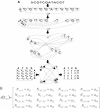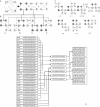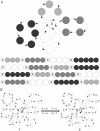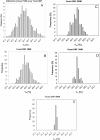Rational design of DNA sequences for nanotechnology, microarrays and molecular computers using Eulerian graphs
- PMID: 15333695
- PMCID: PMC516071
- DOI: 10.1093/nar/gkh802
Rational design of DNA sequences for nanotechnology, microarrays and molecular computers using Eulerian graphs
Abstract
Nucleic acids are molecules of choice for both established and emerging nanoscale technologies. These technologies benefit from large functional densities of 'DNA processing elements' that can be readily manufactured. To achieve the desired functionality, polynucleotide sequences are currently designed by a process that involves tedious and laborious filtering of potential candidates against a series of requirements and parameters. Here, we present a complete novel methodology for the rapid rational design of large sets of DNA sequences. This method allows for the direct implementation of very complex and detailed requirements for the generated sequences, thus avoiding 'brute force' filtering. At the same time, these sequences have narrow distributions of melting temperatures. The molecular part of the design process can be done without computer assistance, using an efficient 'human engineering' approach by drawing a single blueprint graph that represents all generated sequences. Moreover, the method eliminates the necessity for extensive thermodynamic calculations. Melting temperature can be calculated only once (or not at all). In addition, the isostability of the sequences is independent of the selection of a particular set of thermodynamic parameters. Applications are presented for DNA sequence designs for microarrays, universal microarray zip sequences and electron transfer experiments.
Figures







References
-
- Benight A.S., Pancoska,P., Owczarzy,R., Vallone,P.M., Nesetril,J. and Riccelli,P.V. (2001) Calculating sequence-dependent melting stability of duplex DNA oligomers and multiplex sequence analysis by graphs. Methods Enzymol., 340, 165–192. - PubMed
-
- SantaLucia J. Jr, Kierzek,R. and Turner,D.H. (1991) Stabilities of consecutive A.C, C.C, G.G, U.C, and U.U mismatches in RNA internal loops: evidence for stable hydrogen-bonded U.U and C.C.+ pairs. Biochemistry, 30, 8242–8251. - PubMed
-
- SantaLucia J. Jr, Allawi,H.T. and Seneviratne,P.A. (1996) Improved nearest-neighbor parameters for predicting DNA duplex stability. Biochemistry, 35, 3555–3562. - PubMed
-
- Xia T., SantaLucia,J.,Jr, Burkard,M.E., Kierzek,R., Schroeder,S.J., Jiao,X., Cox,C. and Turner,D.H. (1998) Thermodynamic parameters for an expanded nearest-neighbor model for formation of RNA duplexes with Watson–Crick base pairs. Biochemistry, 37, 14719–14735. - PubMed
Publication types
MeSH terms
Substances
Grants and funding
LinkOut - more resources
Full Text Sources
Other Literature Sources

